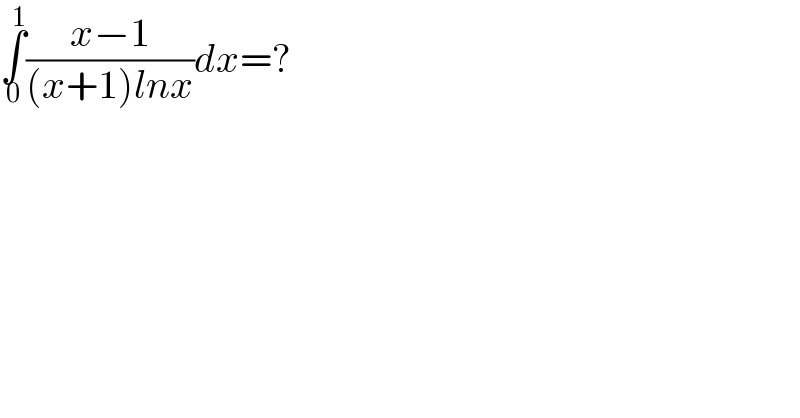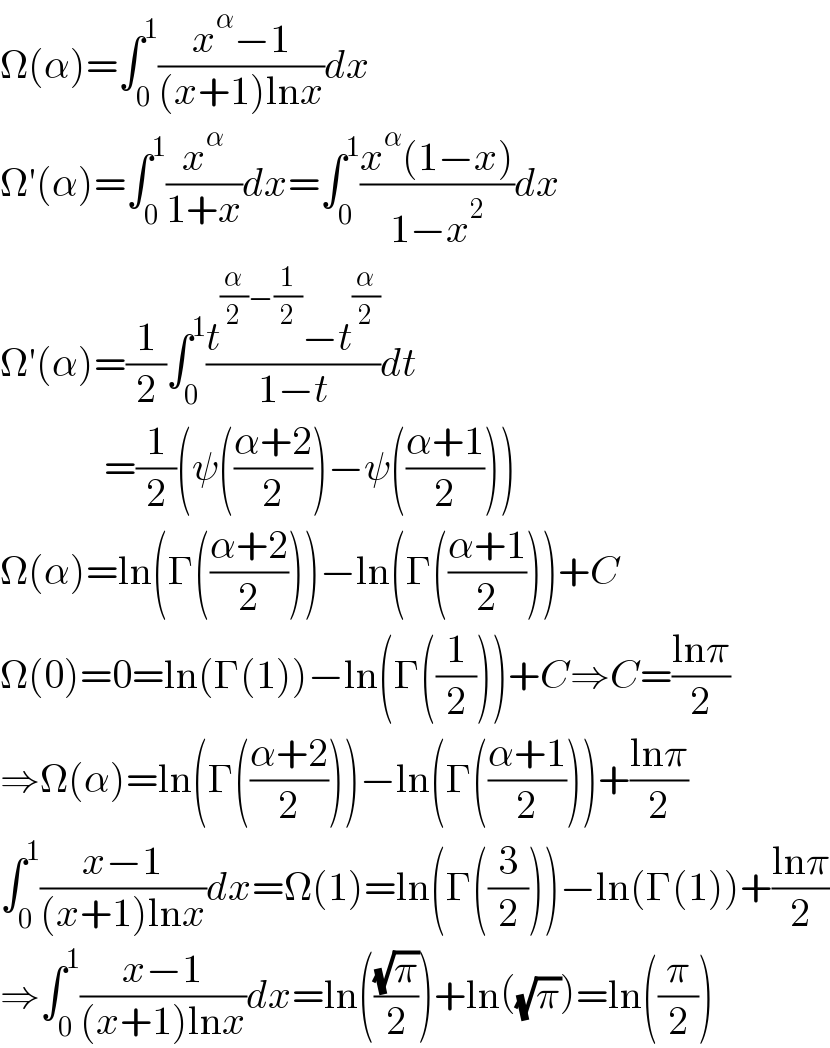Question Number 182529 by sciencestudent last updated on 10/Dec/22

$$\underset{\mathrm{0}} {\overset{\mathrm{1}} {\int}}\frac{{x}−\mathrm{1}}{\left({x}+\mathrm{1}\right){lnx}}{dx}=? \\ $$
Answered by Ar Brandon last updated on 10/Dec/22

$$\Omega\left(\alpha\right)=\int_{\mathrm{0}} ^{\mathrm{1}} \frac{{x}^{\alpha} −\mathrm{1}}{\left({x}+\mathrm{1}\right)\mathrm{ln}{x}}{dx} \\ $$$$\Omega'\left(\alpha\right)=\int_{\mathrm{0}} ^{\mathrm{1}} \frac{{x}^{\alpha} }{\mathrm{1}+{x}}{dx}=\int_{\mathrm{0}} ^{\mathrm{1}} \frac{{x}^{\alpha} \left(\mathrm{1}−{x}\right)}{\mathrm{1}−{x}^{\mathrm{2}} }{dx} \\ $$$$\Omega'\left(\alpha\right)=\frac{\mathrm{1}}{\mathrm{2}}\int_{\mathrm{0}} ^{\mathrm{1}} \frac{{t}^{\frac{\alpha}{\mathrm{2}}−\frac{\mathrm{1}}{\mathrm{2}}} −{t}^{\frac{\alpha}{\mathrm{2}}} }{\mathrm{1}−{t}}{dt} \\ $$$$\:\:\:\:\:\:\:\:\:\:\:\:\:=\frac{\mathrm{1}}{\mathrm{2}}\left(\psi\left(\frac{\alpha+\mathrm{2}}{\mathrm{2}}\right)−\psi\left(\frac{\alpha+\mathrm{1}}{\mathrm{2}}\right)\right) \\ $$$$\Omega\left(\alpha\right)=\mathrm{ln}\left(\Gamma\left(\frac{\alpha+\mathrm{2}}{\mathrm{2}}\right)\right)−\mathrm{ln}\left(\Gamma\left(\frac{\alpha+\mathrm{1}}{\mathrm{2}}\right)\right)+{C} \\ $$$$\Omega\left(\mathrm{0}\right)=\mathrm{0}=\mathrm{ln}\left(\Gamma\left(\mathrm{1}\right)\right)−\mathrm{ln}\left(\Gamma\left(\frac{\mathrm{1}}{\mathrm{2}}\right)\right)+{C}\Rightarrow{C}=\frac{\mathrm{ln}\pi}{\mathrm{2}} \\ $$$$\Rightarrow\Omega\left(\alpha\right)=\mathrm{ln}\left(\Gamma\left(\frac{\alpha+\mathrm{2}}{\mathrm{2}}\right)\right)−\mathrm{ln}\left(\Gamma\left(\frac{\alpha+\mathrm{1}}{\mathrm{2}}\right)\right)+\frac{\mathrm{ln}\pi}{\mathrm{2}} \\ $$$$\int_{\mathrm{0}} ^{\mathrm{1}} \frac{{x}−\mathrm{1}}{\left({x}+\mathrm{1}\right)\mathrm{ln}{x}}{dx}=\Omega\left(\mathrm{1}\right)=\mathrm{ln}\left(\Gamma\left(\frac{\mathrm{3}}{\mathrm{2}}\right)\right)−\mathrm{ln}\left(\Gamma\left(\mathrm{1}\right)\right)+\frac{\mathrm{ln}\pi}{\mathrm{2}} \\ $$$$\Rightarrow\int_{\mathrm{0}} ^{\mathrm{1}} \frac{{x}−\mathrm{1}}{\left({x}+\mathrm{1}\right)\mathrm{ln}{x}}{dx}=\mathrm{ln}\left(\frac{\sqrt{\pi}}{\mathrm{2}}\right)+\mathrm{ln}\left(\sqrt{\pi}\right)=\mathrm{ln}\left(\frac{\pi}{\mathrm{2}}\right) \\ $$
